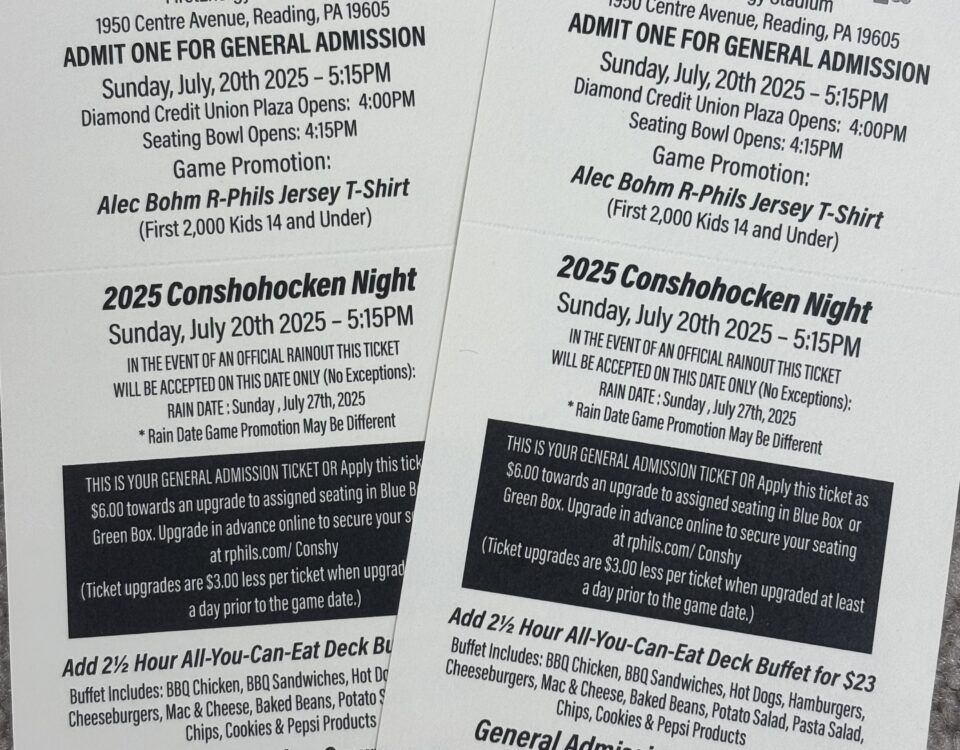
Wawa is 60 years old today! When did Store 67 open?
April 16, 2024
Ambucs Restaurant Rally May 19th all the details here!
May 8, 2024Conshohocken Town Clocks (Another Useless File) Can You Believe I have a File on Town Clocks?
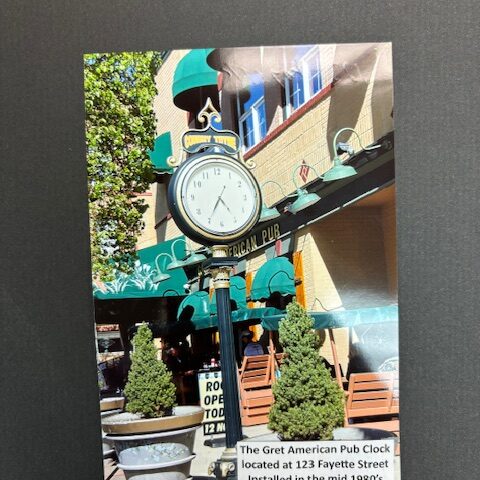
Another Useless File
Conshohocken Town Clocks
Can You believe I have a file on Town Clocks
By Jack Coll
April 25, 2024 (Published May 5, 2024)
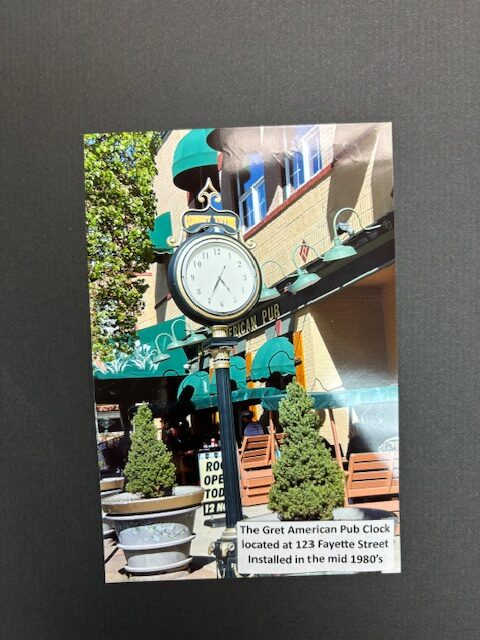
For those of you who regularly follow my columns on Conshystuff.com you might be familiar with the term “Useless File.” With time on my hands, I’ve been spending a little bit of time cleaning out my files that I’ve spent a half a century assembling. Every once in a while, I come across a file thinking what the heck was I thinking when I wasted a file-folder to file this subject!
So nearly fifty years later as I come across it for the second time in my life, I’m pretty confident about dropping the file in the recycling bin along with other useless files like “Street Lights” and “The crazy guy who ran around the borough naked thinking he was an Indian chief”
The borough of Conshohocken has had a number of town clocks over the years, a town clock can be defined as a clock displayed to the public in a very visible location. There was a time when we didn’t have clocks in our automobiles, we didn’t have cell phone clocks, today’s cell phones not only have a clock, but they have a camera, your favorite music, and if you put the phone on vibrate and place it behind you while driving, you can get brief back-rubs.
But back in the day, if you didn’t own a watch, town clocks were very valuable to anyone and everyone who for one reason or another needed a public town clock to keep them on schedule for the day, and Conshohocken had a number of town clocks over the years, and this brings me to yet another useless file taking up space in one of my filing cabinets.
So, as I crack the useless file open, here’s the story of a few town clocks with a little bit of background information. The first article on top is from the Conshohocken Recorder Newspaper which was in existence from 1869-2008. An article dated August 7, 1952, tells the story of a town clock that was installed in 1893 at the Hoffecker School located on East Third Avenue. The Hoffecker School was built in 1868 and opened to students in 1869. When the school opened it was known as the Harry Street School, later renamed for Ruben Hoffeker, who was a principal at the school, Hoffeker was later named Montgomery County Superintendent of schools. The school was later renamed Hervey S. Walker Elementary School and in the 1980’s renamed again to Conshohocken Elementary School.

Let’s get back to the clock. In 1893, a large clock with ten inch bronze roman numerals was installed near the schools rooftop along with a bronze bell that measured three-feet by three-feet. The clock was made by the Ansonia Clock Company founded in 1851 in Ansonia, Connecticut. The company later moved to Brooklyn, New York in 1878, where the four-foot by four-foot clock was manufactured and required a weekly winding with a crank or windlass. The company manufactured hundreds of different types of clocks over the years and closed the business in 2006, after 155 years of operation.
In the summer of 1952, the Hoffeker School was getting the roof replaced and at that time after nearly 60 years of service to the community it was decided to remove the rooftop clock that hadn’t worked in years due to the fact that replacement parts were no longer available. The accompanying three-foot by three-foot bronze bell that rang on the hour was also removed and placed in front of the school. The bronze bell has been preserved since 1952 and can be seen outside the main entrance to the school to this day.
Another notable town clock hung in the face of the First National Bank of Conshohocken once located on the southwest corner of Hector and Fayette Street. The clock was installed when the building was constructed in 1924, on the former George Washington Jocoby property. Jacoby was a prominent supervisor of a marble yard. His residence once located on the corner of Hector and Fayette Street was known as the borough’s first “Mansion” and was purchased by the bank in 1873. The former “Mansion served as the First National Bank of Conshohocken from 1873 until 1923, when the building was demolished and the beautiful marble-front, modern-day bank was opened in 1924.

Coll’s Collection
In 1955 the bank merged with Philadelphia National Bank, and purchased the Jones property at Fifth Avenue and Fayette Street and moved the banking operations to its new location in 1956. Following years of merger’s, the bank currently operates as the Wells Fargo Bank. The Washington Fire Company purchased the former bank building at Hector and Fayette Streets in 1959, when the building was demolished under the urban redevelopment act of the 1960’s and 1970’s, Washington Fire Company preserved the clock and for many years the clock hung above the bar in the company’s social hall.
Another well-known time-piece was the clock atop St. Mary’s Church, which had a bell that rang on the hour, every hour, twenty four hours a day. The clock was installed in 1951, when the church edifice was built at a cost of $225,000.
A modern-day clock was once located blinking out the time and temperature over the Con-Fed Bank, (Conshohocken Federal Bank) once located at Second Avenue and Fayette Street. The bank later became the Commonwealth Federal Savings Bank. Over the years the building has served the community as a retail space and a number of restaurants have come and gone at the former bank building as well.

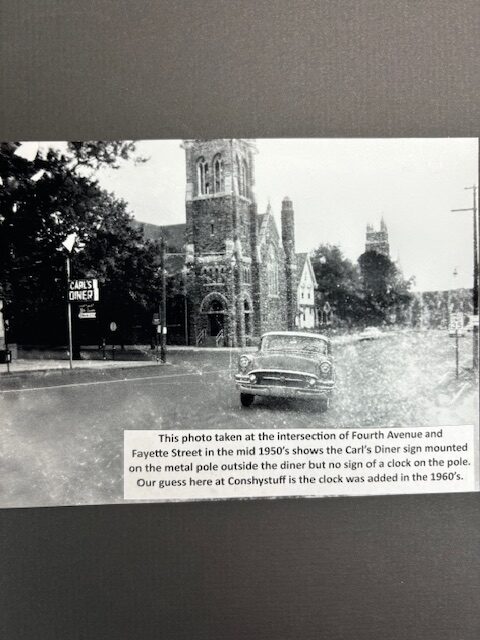
Then there’s the sidewalk town-clock on the northeast corner at Fourth Avenue and Fayette Street. I’m not sure exactly when the clock was installed on the sidewalk sign-pole, perhaps we can check in with our 401 Diner historian Bill Dantiz, but I can tell you this. Sometime in the late 1940’s, when Bill Pounds owned the diner, that he converted from a beauty shop, Pounds installed the sidewalk pole with a sign stating “Bill’s Diner,” but no clock. Carl Aumann who purchased the Diner in 1950, redesigned the pole with a sign “Carl’s Diner,” but his sign hung much lower on the pole, and as of the mid 1950’s, there was still no clock on the pole. Aumann owned the diner from 1950-1969, when Bill Danitz purchased and owned the diner for the next thirty years until 1999. I’m assuming the diner clock was installed sometime between 1960-1970, that’s just a guess. As far as I know the clock was still functioning when it was called the “401 Nirvana” in 2013.

Sometime in the mid-to-late 1980’s, Chuck Hemcher, owner of the Great American Pub installed a town clock in front of the Pub located at 123 Fayette Street. Hemcher, along with his business neighbor Jim Flanigan who owned The Boathouse were struggling to beautify lower Fayette Street. Although the borough had very little money to contribute, Hemcher and Flanigan used their own funds to paint the rusty light poles, install benches and large flower pots along the one hundred block.
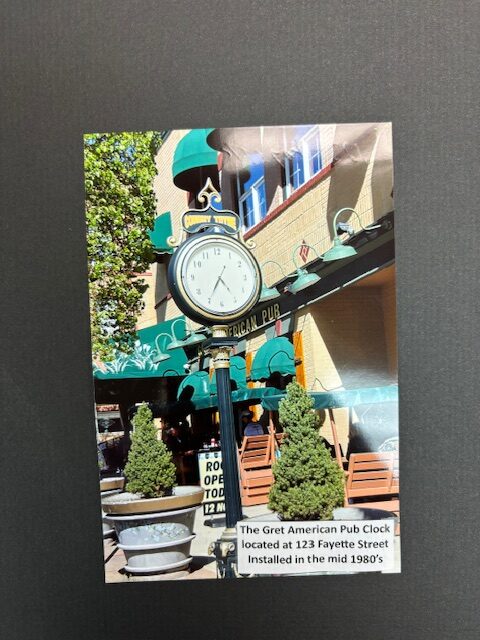
The addition of the clock led to installing hanging flower baskets on the clock and the other street poles along the block. Thanks to the Pub and Boathouse and Flocco’s efforts they were able to transform the lower Fayette Streetscape into a beautiful looking entrance into Conshohocken.
In the summer of 1990, a town clock was installed outside the William Moore Funeral Home located at the other end of town at 708 Fayette Street. The William A. Moore Funeral Home has been in business for nearly 90 years having opened on Fayette Street in the 1930’s.
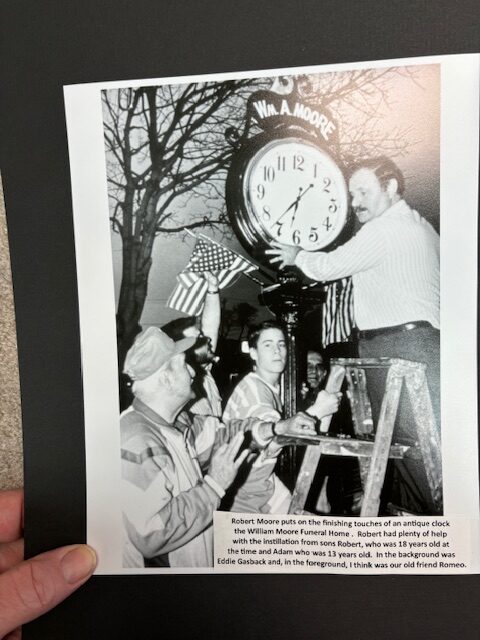
I always felt that William Moore never got the credit he deserved for his involvement in the borough’s successful redevelopment. In the early 1960’s, he was part of constructing the borough’s comprehensive plan, although he wasn’t an official member of the planning commission in 1963, he worked alongside of George Rafferty and Moore’s nephew Eddie Moore. William Moore was a civic leader with great vision and at the time stated the importance of the type of buildings that would eventually be constructed in the lower end although he wouldn’t live long enough to witness the buildings constructed in the lower end throughout the 1980’s and 1990’s, he certainly had a deep interest in the success of Conshohocken’s urban redevelopment. Moore was President of the Conshohocken Chamber of Commerce and worked with Eddie Moore as chairman for the Fourth of July committee for many years, a committee he and Eddie established in 1951.
The clock installed in front of Moore’s property was appropriately an authentic antique clock that Robert Moore stated at the time that some friends secured the clock for the Moore’s in an upstate Pennsylvania antique store costing several thousand dollars.
There was a time where it seemed that every main street in America had a town clock, or two, or three. Town clocks served a purpose to travelers, shoppers, residents and businesses. It seems to me that very few if anyone relies on a town clock to keep them on schedule anymore.
The town clocks that contributed to me keeping a file on them were all useful and added a little visual charm to our town, however I’m not sure it’s a file that I need to keep around for generations to come.

Perhaps you know of, or remember a town clock that didn’t show-up in my file, if so, feel free to comment below.
See-you next time when I come across another useless file.
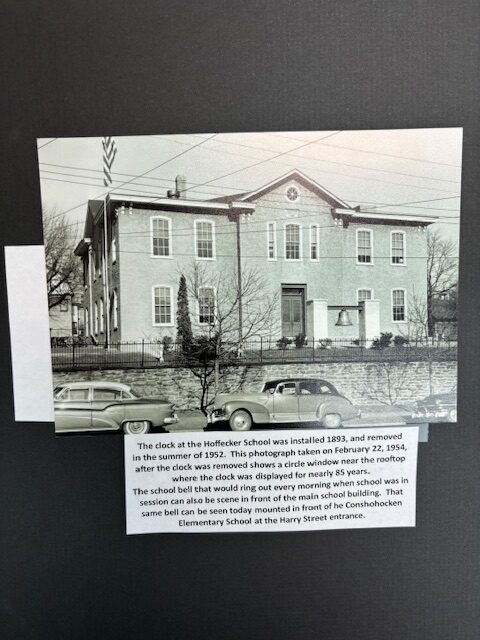
The clock at the Hoffecker School was installed 1893, and removed
in the summer of 1952. This photograph taken on February 22, 1954,
after the clock was removed shows a circle window near the rooftop
where the clock was displayed for nearly 85 years.
The school bell that would ring out every morning when school was in
session can also be scene in front of the main school building. That
same bell can be seen today mounted in front of the Conshohocken
Elementary School at the Harry Street entrance.

